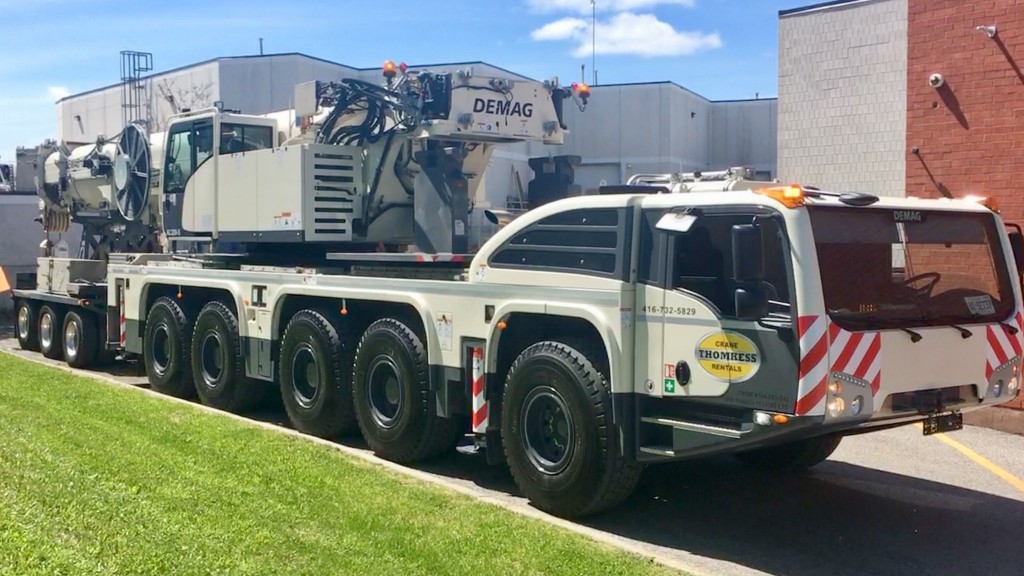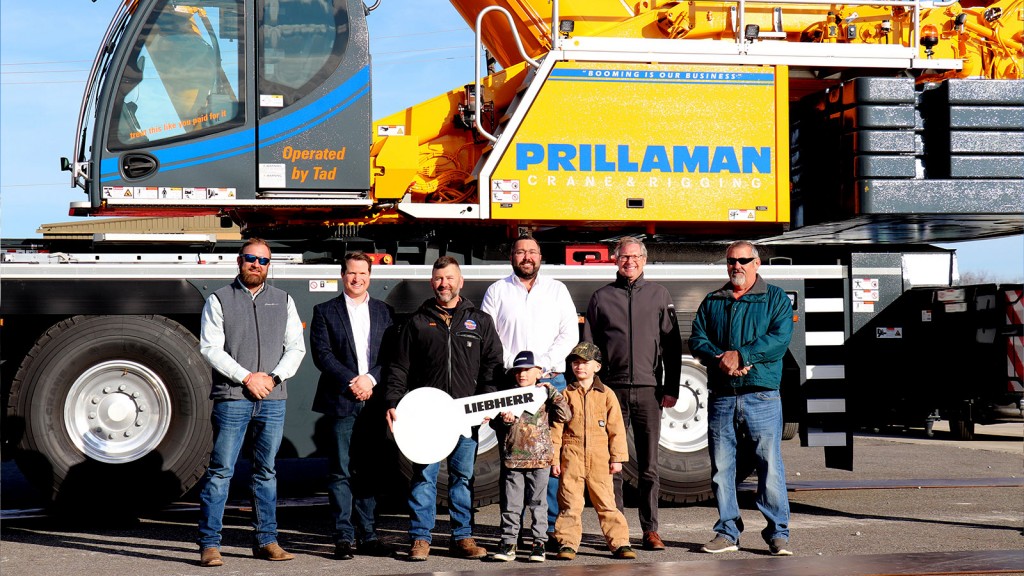
Erecting multiple sections of a 200-foot-high communications tower looks like a tall order. Thanks in no small part to a technologically advanced all-terrain crane doing the lifting, the installation of that tower at the new Belleville Police Services headquarters in Ontario in November went off with hardly a hitch.
"That was one of the most straightforward ones we've ever done actually as far as cell towers go. It was a pretty easy one," said crane operator Bruce Cringan, who works for Thornhill, ON-based ThomKess Crane Rental.
The craning part of the job took only about three hours. Much of the credit was due to the 2019 Demag AC 220-5, a 220-tonne capacity, five-axle all-terrain crane that ThomKess acquired about a year earlier. That crane boasts 255.9 feet of maximum boom extension, without a jib, easily enough length to lift the tower sections into place.
"Most cranes in that capacity you probably would have had to put the jib on to do it," Cringan said. "We were able to do it on main boom."
When installing towers, Cringan typically stands the pieces up on the ground. The Belleville job was no exception.
"In this case, the lifting radius was 72 feet from the centre of the crane to the centre of the load," Cringan said. "So you try to stand the piece, and you want to have the piece at roughly the correct radius. You run it all the way up, and that takes a little bit of time to hoist up that high."
Nice and smooth
While routine for Cringan and the crane, the lift still required great attention to detail. Not the least was that he had to carefully lower each section so that the three ironworkers, each harnessed to one of the tower's three poles, could grab the structure as it descended and fasten it in place.
"You'll want to come in nice and smooth and you'll come in just a couple feet above the guys' heads and you'll swing it right over and stop over the tower," Cringan explained. "And they can reach up and grab the corners and you hoist down nice and slow. You stop once you're about six inches from making the connection and then they've got their spud wrenches and their connection bars and they'll get it all lined up."
All the while, Cringan received hand signals from the ironworkers as well from a supervisor on the ground. As the ironworkers began tightening the bolts, the crane had to hold the weight of the individual sections. Once they started torquing the bolts, Cringan lowered the boom so the tower took the full weight of the section as the ironworkers finished tightening the connections.
Part of his game was accounting for deflection of the boom because of that weight.
"When the load comes off, my radius will decrease because the flex is coming out of the boom," Cringan said. So rather than hoist down the load, he boomed down.
Assisting Cringan on the Belleville job was apprentice Tyler Danabie, who helped with the rigging and also drove the truck that hauled a second trailer carrying the crane's counterweights. The crane itself tows a trailer called a boom dolly, which supports the boom.
"I don't even think we were on site three hours," said Cringan, who has only had his full operator's ticket for three years. "Like, set up, stack the tower and get out of there. It was quick. The guys on the ground did an awesome job. Everything was ready to go. The three climbers did a great job. Yeah, it was pretty slick."
Heaviest tower
Broadband Tower Services, which oversaw the installation, hired ThomKess to do the crane work. Broadband owner Mark Allott said he was pleased with the result. The sole difficulty was in landing the first section because the tower foundation was built into a small berm.
"We actually had to use our Bobcat and a heavy strap and pull one leg a little bit," Allott said. "But that was the only challenge."
The total job from Broadband's end took eight hours – exactly. "I remember seeing the bill," Allott said. That included installing the tower's antenna while it was still on the ground. Including installation, the tower cost about $350,000.
The tripole tower – with legs rising in parallel rather than tapering – was designed for any future use the police service could think of, Allott said. Police Chief Ron Gignac told the Belleville Intelligencer newspaper that the tower will be part of upgraded telecommunications, radio and 911 systems.
The police will also be able to rent space on the tower to private telecommunications firms, the news report said.
The new $26 million headquarters is scheduled for completion in 2020.
"The tower was heavy, 47,000 pounds complete," Allott said of the galvanized steel structure fabricated by Maxtower Company Ltd. of Brantford, ON. "So typically, a 200 footer we build would be around 18,000 pounds. This was the heaviest one that I've had to put up."
It won't be the last. London, Ontario-based Broadband will be installing other towers, including for the City of Belleville, and will be calling on ThomKess to do the crane work.
"We've worked for them for years and years," said ThomKess co-owner Brad Thomson. "Mark's a great guy. He's one of the old-school handshake guys."
Based in Bobcaygeon
Thomson and his partner Mark Kessler founded ThomKess about 14 year ago. They were both working as crane operators when circumstances prompted them to take a gamble. "Mark and I were playing cards one night and we decided to open our own business," Thomson said.
It wasn't easy. Early on, they'd sell personal effects just to put fuel in their cranes. To keep the business afloat, Thomson took a loan on his house at Bobcaygeon, where the company still has its head office.
ThomKess has grown to employ 12 other crane operators, a full-time mechanic and four office staff, including Thomson's mother, whom he "dragged kicking and screaming out of retirement" to do the books.
The company's big yard is now in Aurora with a repair shop in Richmond Hill that parks half a dozen cranes. ThomKess is also in the midst of moving some of its operations to a 10-acre site in New Market.
"Right now we basically service from Niagara out to London, up to Orillia, out to Cobourg," Thomson said. "That's a pretty huge area."
A big, big step
The company's fleet now boasts 14 cranes, including the Demag AC 220-5. "For us, it was a big, big step," Thomson said. It replaces a similar capacity crane that was starting to have multiple issues. "If you want to properly service your customers, you can't be breaking down," he said.
Ontario-based dealer Cropac Equipment knew Thomson was looking for a new crane and flew him and other interested parties to Germany to check out the Demag. "And we ended up buying one," Thomson said.
Terex Corporation revived the Demag brand to considerable fanfare at the massive Bauma trade show in Munich in 2016. More recently, in 2019, Terex sold Demag to Japan-based crane manufacturer Tadano.
Among the features of the AC 220-5 is the IC-1 Plus control system, which Cringan described as "very user friendly" and which enables the crane to travel with more counterweight than similar cranes in its class. "So you can do a lot more jobs without needing extra trailers of counterweight."
The IC-1 Plus also enables the crane to extend each of its four outriggers to different lengths. That allows the crane to set up in tight spaces. That wasn't an issue on the Belleville Police tower job, however, as the crane set up on an expansive, level surface of compacted gravel.
"It's extremely maneuverable," Cringan said of the AC 220-5. "You get it into all kinds of tight places where you previously would have never imagined to get a crane this size into. But that wasn't really coming into play on this job."
Keith Norbury is a freelance writer.
This article originally appeared in the February 2020 issue of Heavy Equipment Guide. Check out the digital edition here.



